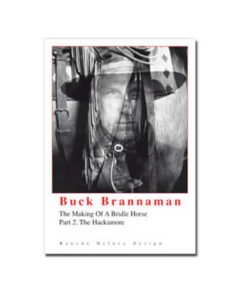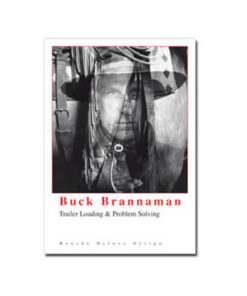Greetings from Tom Dorrance
$45.00
1 in stock (can be backordered)
Product Description
In ‘Greetings! From Tom Dorrance’, Tom talks about horses & true unity – willing communication between horse and human. Watch as Tom works with horse and people projects with excerpts from the book True Unity.
Bryan Neubert talks about learning with horses and how the words of his mentors would come to make sense, sometimes years after they were first spoken. “Maybe I just wasn’t ready for it before. But then I just got more ready for it.”
“When I observe people and horses, it often seems to me that when the horse is trying to avoid something, or maybe is not doing what the rider asks of him, it is because the horse’s sense of self-preservation is immediately taking effect… the rider needs to recognize the horse’s need for self-preservation in Mind, Body and the third factor, Spirit… He needs to realize how the person’s approach can assure the horse that he can have his self-preservation and still respond to what the person is asking them to do.”
Martin Black visits with Tom about how to build speed and confidence with a fractious horse.
“The older I get the more it’s beginning to dawn on me how most people seem to have so little feel of the whole horse – of what’s going on in that part.”
Bryan Neubert works under Tom’s guidance to saddle a filly for the first time.
“The best thing I try to do for myself is to try to listen to the horse. I don’t mean let him take over. I listen to how he’s operating: what he’s understanding or what he doesn’t understand; what’s bothering him and what’s not bothering him. I try to feel what the horse is feeling and operate from where the horse is. This is what I’m trying to get the riders to do, to operate from where the horse is instead of trying to operate from where the rider is. I like to work from where the horse is, to get him to be able to operate wherever and whenever I need him.”
Tom commentates as Bryan Neubert handles with a three year old colt in preparation for saddling.
“You need to learn about what’s going on inside the horse. But the inside of that horse is right in his innards, you might say; and what brings on trouble is disturbance, both mental and physical, being brought to the inside of the horse – right in his innards. If you can feel this, it will tell you a lot about what’s causing his trouble.”
A student asks for Tom’s advice regarding a stallion that pulls away.
“If a person can understand what took place, then maybe he can help the horse get in a position that will come out better, that will help him avoid getting into a position that’s not so good. There’s such a variation of situations that you can’t say, ‘Do this and you get that’. People have to rely on themselves. I tell people that it has to come right out of the inside of themselves, the end result. There can be some direction, or support and encouragement, but the feel itself can come from no one but themselves; they will know when the feel actually becomes effective and when they are understanding.”
Tom works with a horse that pulls back.
“There’s a ‘time’ in there; it’s just as well not to crowd the horse if he isn’t ready for it. You keep offering, trying to help as much as you can, without troubling him too much about it. Then, there will be a day when it will clear right up.”
Tom instructs Bryan Neubert on how to help a colt get loose through the hip and hindquarter, in preparation for saddling and riding.
“You find a place that fits the horse. It will vary on different individuals. As they get more advanced, they know how to position for different things. You get the horse so they will come through, regardless, so that any place you reach for them, this ‘good feel’ comes. That helps them to shift their weight for the different transitions. They learn to shift their weight so they can place their feet, so they are balanced. You try to help them as little as possible, but sometimes that is everything you have; or the other extreme, so little it’s hardly measurable.”
Tom, ‘What I learned about the horse I learned from the horse.’
“People try to crow too much on themselves for the time they have. I keep telling them, not necessarily to try to get it to work for them today, but to try to figure out what is taking place.”
Tom sets out several obstacles for his clinic riders to experiment with. Encouraged by Tom’s typical witty and positive commentary, the students work to build trust and confidence in their horses.
“When you put the horse first and try to work from where the horse is, back to the person, it makes it easier for the horse to find. I’d say most people start from where the person is and try to get the horse to work back to them. All the time, the horse is trying to tell you where he is. Listen to the horse. Try to find out what the horse is trying to tell you.”
A student asks for Tom’s advice on how to improve his horse’s turnaround.
“Riders may want to get an answer to their questions right early – on the surface. I want them to try to figure out something; I want them to work at figuring out the whole horse – his mind, body and spirit. Maybe they will figure out what they are missing.”
A second clip presents the continuation of improving the turnaround with the same horse and rider combination.
“I didn’t used to elaborate on the third factor, spirit; I only just mentioned it. But I’ve begun to wonder about it in the last few years. Maybe if people got to realizing the importance of that part of the horse, they could get more feel and understanding from right in the horse’s innards. Then they could try to figure out the mental and physical parts. I’ve felt this in horses all my life, but I don’t think I realized how important it was to try to calm that inward part down. I was always working on the surface, both mentally and physically – not getting right down to the inside of the horse. No one is going to get this without coming right out of the inside of themselves. The rest of it has to come from inside the horse. Mind, body and spirit is what we are talking about here.”
In the last video segment, Tom recaps with his students after a successful clinic. Additional footage from this clinic is presented in the DVD ‘Feel, Timing and Balance’.
Approximate running time, two hours.
“I was born May 11, 1910, number six of eight kids. Family, horses and cattle became an important part of my early life. The last 89 years have been good to me, and good for me. In looking back through all these many years, I have expereinced a great life. Looking for the good in poeple and animals has helped me get a better understanding of life in general. I hope this video will help you in your search for a better understanding and communication with your horse.”
Best Wishes, Tom Dorrance, December 1999
3 reviews for Greetings from Tom Dorrance
You must be logged in to post a review.
Related products
-


Remembering Ray Hunt DVD
5.00 out of 5$29.95Brands:Ray HuntRead more -

The Making of the Bridle Horse Part 2 with Buck Brannaman
5.00 out of 5$49.95Brands:Buck BrannamanAdd to cart -

Horsemanship with Ray Hunt
5.00 out of 5$69.95Brands:Ray HuntRead more -

The Making of a Bridle Horse Series with Buck Brannaman
5.00 out of 5$134.85Brands:Buck BrannamanAdd to cart -

Trailer Loading & Problem Solving with Buck Brannaman
5.00 out of 5$49.95Brands:Buck BrannamanAdd to cart




Kate (verified owner) –
Truly a great horseman with such good and honest intentions. Absolutely loved watching this DVD!
cattledog66 –
Love this. Every new watch you get a bit more insight. Like “true unity” you can never re-do too many times…
thewylowes –
I simply love all of the dvds with Tom. His kind soul shines through in his messages. Everything he talks about can be applied to your relationship with your horse and your relationships with family and friends. All of the dvds of footage at his clinics are wonderful!